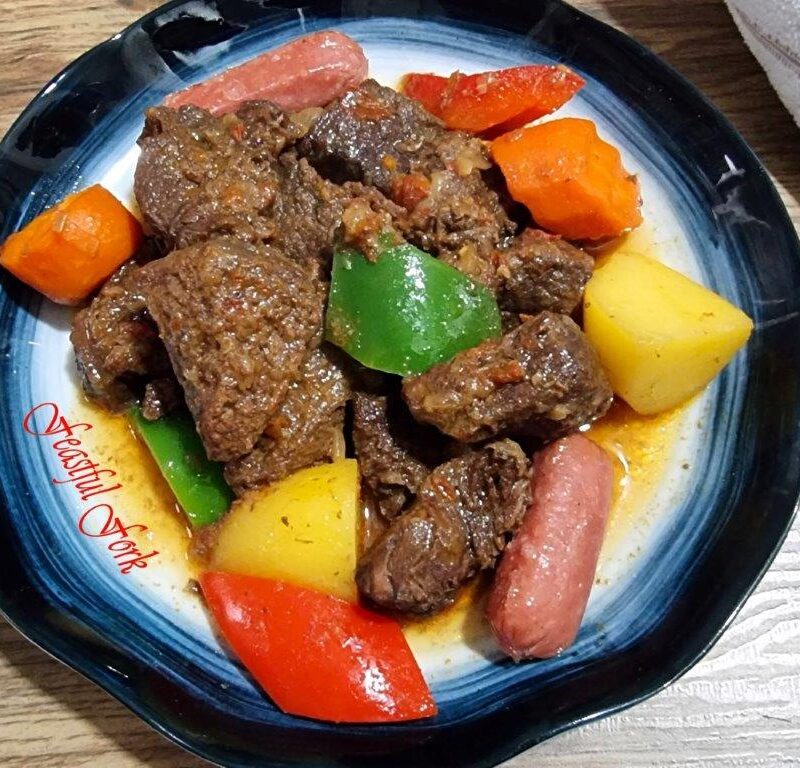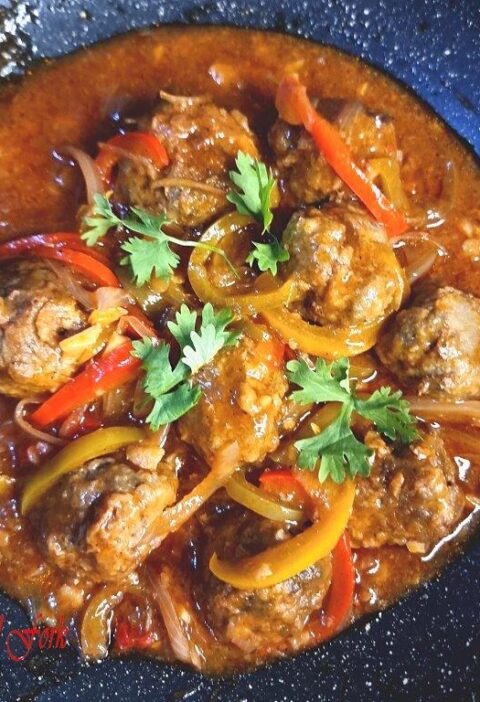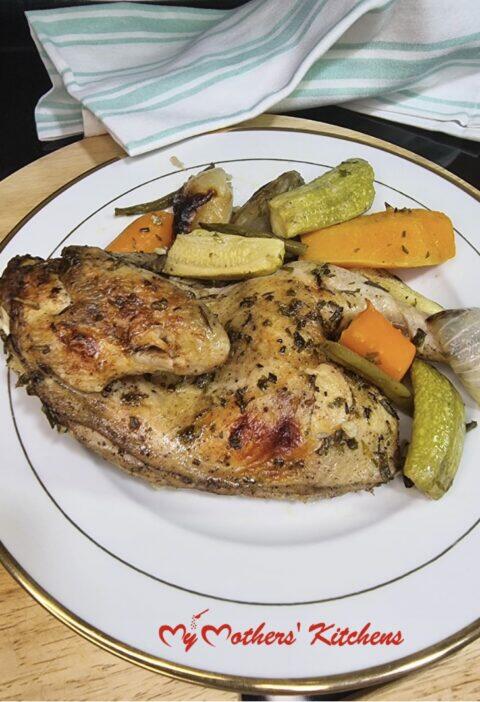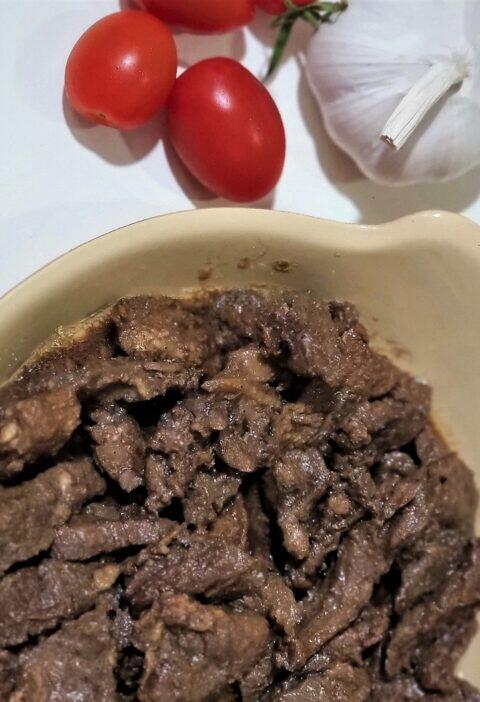Beef afritada is one of the three popular Filipino tomato-based stews that are mistaken for each other, the other two being the caldereta and mechado. In the beef afritada recipe you will find in this post, the addition of hotdogs adds a unique twist that makes this dish even more accessible and enjoyable.
Before we dive in, let us first see the differences between the three Filipino stews:
Caldereta
Caldereta is typically made with beef, though goat, pork, and chicken versions also exist. The dish is known for its rich and hearty sauce made with liver spread or pâté, giving it a creamy, savory depth. Potatoes, carrots, bell peppers, and sometimes olives or cheese are added for extra flavor. Caldereta has a slight spicy kick, often enhanced with chili peppers.
Afritada
Afritada, on the other hand, is lighter in texture and flavor. Chicken or pork are the usual proteins, cooked with a simpler tomato sauce than caldereta’s. This stew features a classic combination of potatoes, carrots, and bell peppers, but it’s less rich as it doesn’t include liver spread or cheese. Afritada focuses on the bright, tangy flavors of tomatoes with minimal spices.
Mechado
Mechado traditionally uses beef, but its signature element is the insertion of pork fat into the beef, mimicking a “wick” (or mitsa in Filipino), hence the name. The sauce is similar to that of caldereta, yet simpler. It lacks the creaminess of liver spread but may incorporate soy sauce for a savory, umami touch. Mechado is earthy with less spice compared to caldereta.
Essential Ingredients
Beef Afritada is a saucy Filipino beef stew that combines fork-tender beef, a flavorful tomato sauce, and a variety of vegetables. Essential to this dish are the main components: pounds of beef chuck, tomato sauce, beef broth, and an array of fresh produce and spices.
Beef selection
Pounds of beef chuck are most commonly used in this dish because of their rich marbling, which yields succulent, fork-tender meat when cooked properly. This cut stands up well to the low and slow cooking process, becoming more flavorful and tender over time.
Vegetables used
Bell peppers are a staple, contributing a sweet and slightly tangy flavor, while potatoes act as a satisfying, hearty addition. Carrots add color and sweetness, which balance the delicious components of the stew. Peas are optional as they are often included for their subtle flavor and texture.
Seasoning and spices
Sauteeing cloves of garlic and onions create a fragrant base for the stew, while salt and black pepper are used to season beef afritada. They enhance the natural flavors of the beef and vegetables.
Substituting ingredients
You can easily swap out some ingredients in beef afritada without losing its classic flavors. For instance, you can use bite-sized chicken pieces instead of beef for a delicious chicken afritada—the same great taste, just a different protein. If you’re avoiding gluten, try using gluten-free soy sauce or tamari in place of fish sauce. And if you have fresh tomatoes on hand, they work just as well as canned tomato sauce. Just add a little white sugar to balance the sweetness and tanginess of the dish.
Cooking Tips
Ensure that any onion or cloves garlic added to the pan are translucent before adding tomato sauce and other liquids; this contributes to the aromatic foundation of the dish.
Using a combination of beef broth and cups water can also enhance flavor while ensuring enough liquid to cook the beef thoroughly.
Stirring occasionally prevents the ingredients from sticking to the bottom of the pot and burning.
To keep the bell pepper vibrant and slightly crisp, consider adding them towards the last 15 minutes of cooking.
Adding saltless beef bouillon cubes can also enhance the flavor of your stew.
When the stew is nearly complete, do a simple taste test so that you can adjust the seasoning with salt, black pepper, or even a bit of sugar to balance the acidity of the tomato sauce.
Serving the dish over steamed rice or white rice gives a classic, comforting pairing that complements the fine flavors of the beef afritada.
Tips for Tenderizing Beef
Choose the right cut of meat: beef chuck is ideal due to its marbling and connective tissue, which breaks down deliciously during the stewing process. For that perfect fork-tender beef in your afritada, remember that low and slow is the way to go. Cooking the beef at a gentle simmer over a prolonged period allows the tough fibers to break down, resulting in tender meat.
Another method to tenderize beef is to use a meat mallet before cooking, which physically breaks down tough muscle fibers. If time allows, marinating the beef in a tenderizing marinade that contains a natural enzymatic like pineapple juice or papaya extract can also yield tender results.
Adding a bit of acidity to the stew, such as lemon juice or a touch of vinegar, can also aid in tenderizing the meat.
For those using a pressure cooker, this equipment naturally hastens the tenderizing process through high-pressure steam, reducing the usual hours of cooking to under an hour.
Balancing Flavors
Achieving a harmonious flavor profile in beef afritada involves balancing savory, sweet, salty, and acidic tastes. Tomato sauce contributes both acidity and a touch of sweetness, but if the sauce is overly acidic, a small amount of white sugar can be added to counter it.
Adjusting seasoning with salt and black pepper is customary, but moderation is key; it’s easier to add more later than to correct over-seasoning.
A splash of fish sauce can also introduce an umami element and additional depth. On a bright note, a squeeze of lemon juice toward the end of cooking can liven up the stew—just enough to notice but not so much to overpower the other flavors.
Lastly, the flavor can be mellowed and rounded out by adding a few tablespoons of beef broth or even a bit of butter for richness if needed. Taste and adjust as necessary, keeping in mind that the flavors will continue to develop even after the heat is turned off.
Flavor Balancing Table:
| If the stew is too: | Consider adding: |
|---|---|
| Acidic | Sugar or a touch of Butter |
| Bland | Salt, Black Pepper, or Fish Sauce |
| Sweet | A pinch of Salt or a splash of Lemon Juice |
| One-dimensional | Beef Broth or a dash of Vinegar |
Each of these tips and techniques can aid in creating a delicious and satisfying beef afritada that can become a family favorite at mealtime.
Cooking Instructions
- Prepare the Ingredients: Cut the beef chuck and hotdogs (frankfurters) into bite-sized pieces. Mince the cloves of garlic and slice the medium onion. Core and cut the bell pepper into rough squares. Dice the carrots and potatoes roughly. Gather the rest of the ingredients, including the tomato sauce, beef broth, fish sauce, lemon juice, and seasonings.
- Sauté the Aromatics: Heat oil in a large pot over medium heat. Add the garlic and onion, cooking until the onion is translucent. Add the tomatoes and cook while stirring until the tomatoes are broken down.
- Add the beef chunks and stir once. Simmer over medium heat for about an hour and a half or until the beef is tender.
- Add tomato sauce: Pour in the tomato sauce and beef broth, then add the fish sauce for that extra umami punch.
- Add Vegetables: Once the beef is tender, add the carrots and potatoes. Cover the pot and cook until the vegetables are tender. Stir occasionally to ensure even cooking and to prevent sticking. Add the bell peppers halfway through.
- While all of that is happening, gently fry the hotdogs in a separate pan and add to the stew during the last 5 minutes of cooking to ensure that the taste of the sauce incorporates with the hotdogs.
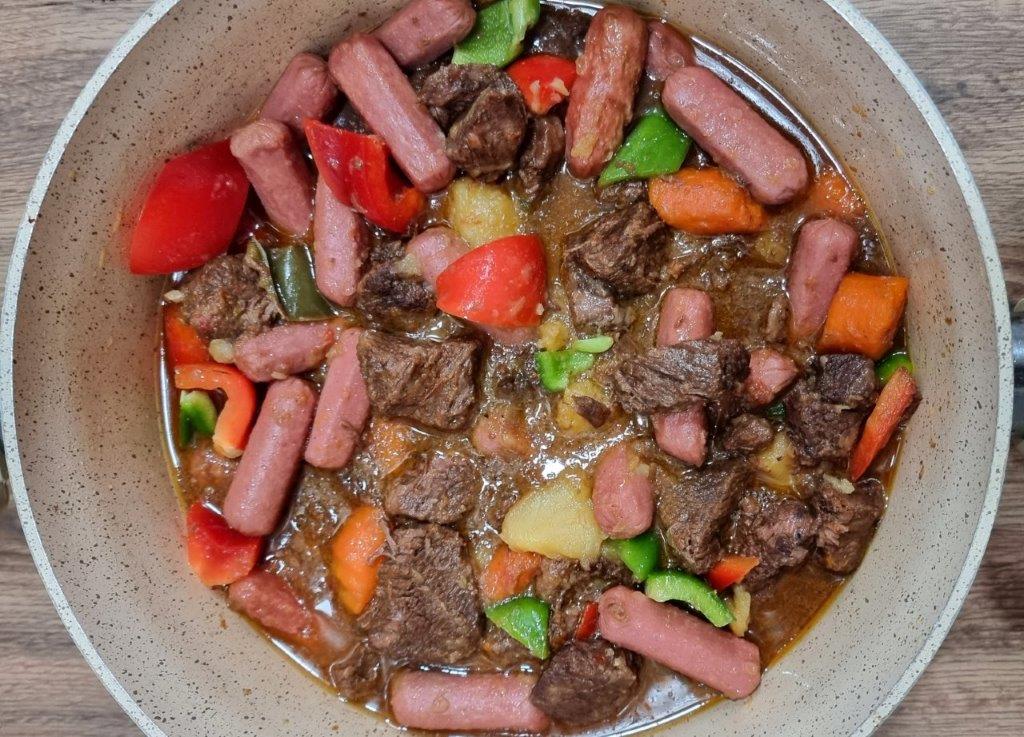
Cooking times and temperature
- Sautéing Aromatics: Garlic and onion should be sautéed on medium heat for 2 to 3 minutes until onions are soft and translucent.
- Simmering Stew: After adding the liquids, bring to a boil and then simmer covered for about 1 ½ to 2 hours. The slow cooking process will make the beef chuck fork-tender.
- Vegetables Cooking: Add the bell peppers during the last 15 minutes of cooking to avoid over-softening.
Note: Cooking times may vary based on the type and cut of beef. A pressure cooker can reduce cooking time to about 30 minutes, while a slow cooker would require approximately 6-8 hours on low heat.
Remember, accurate temperature control and timely checks are key to ensuring the beef and vegetables are cooked perfectly without becoming overly mushy. Remember that cooking on stovetop can vary based on the heat source and cookware used.
Alternate Cooking Methods Table
| Method | Beef Cooking Time | Vegetable Cooking Time |
|---|---|---|
| Pressure Cooker | ~30 minutes | ~5 minutes |
| Slow Cooker | 6-8 hours (low) | Last 1 hour (low) |
| Stovetop | 1 ½ – 2 hours | Last 20-30 minutes |

Beef Afritada With Hotdogs
- Prep Time: 20 minutes
- Cook Time: 1 hour and 30 minutes
- Total Time: 0 hours
- Yield: 4–6 servings 1x
- Category: Main dish
- Method: cooking
- Cuisine: Filipino
Description
A traditional Filipino beef stew that boasts a hearty combination of fork-tender beef and a flavorful tomato sauce with vegetables and hotdogs.
Ingredients
- 1 kg beef chuck, cut into bite-sized pieces
- 1 cups tomato sauce
- 1 medium onion, chopped
- 4 cloves garlic, minced
- 3 medium tomatoes, chopped (or 1 cup chopped canned tomatoes)
- 1 red bell pepper, diced
- green bell pepper, diced
- 1 cups beef broth
- 2 teaspoons fish sauce
- 1 teaspoon lemon juice
- 1 teaspoon white sugar
- Salt and black pepper to taste
- Cooking oil
- 2 cups water (optional, adjust as needed)
Instructions
- Heat oil in a pot over medium-high heat. Brown garlic, then add the onion. Cook stirring until softened.
- Add tomatoes and cook stirring until tomatoes are broken down.
- Add the beef chunks and stir once. Simmer over medium heat for about an hour and a half or until the beef is tender.
- Pour in tomato sauce, beef broth, and add fish sauce, lemon juice, and sugar.
- If using a pressure cooker or slow cooker, adjust the cooking time according to the appliance’s instructions.
- Simmer on medium heat until you achieve that tender beef stew. Add more water if necessary.
- Once the beef is tender, add the carrots and potatoes. Cover the pot and cook until the vegetables are tender. Stir occasionally to ensure even cooking and to prevent sticking. Add the bell peppers halfway through, followed by the hotdogs during the last 5 minutes of cooking.
- Season with salt and pepper to taste.
- Serve your beef afritada over steamed white rice.
Notes
This dish is similar to Beef Mechado but features bell peppers and is not as tomato-centric. Enjoy this rich and comforting dish that is a staple in Filipino cuisine.
Serving Suggestions
Beef afritada is best enjoyed with a serving of carbohydrate to complement its rich flavors. The most traditional pairing is with steamed rice or white rice, which not only soaks up the savory tomato sauce but also balances the hearty nature of the stew.
Alternatively, those looking for a different texture may opt for bread rolls or a crusty bread which can be used to mop up the delicious sauce.
Ideal accompaniments
This Filipino beef stew is rich in flavor and pairs well with side dishes that can add a touch of freshness or a contrasting texture to the meal. A simple garden salad dressed with a light vinaigrette or pickled vegetables can cut through the richness and provide a refreshing palate cleanser. For added variety, beef afritada can also be accompanied by sautéed greens or a medley of roasted vegetables. If an even heartier meal is desired, consider serving it beside a portion of buttered corn on the cob or a bean salad for added protein.
Storing Leftovers
To store leftover beef afritada, let it cool to room temperature within two hours of cooking to prevent bacterial growth. Once it’s cooled, transfer it to an airtight container to lock in the flavor and moisture. In the fridge, it will stay fresh for 3-4 days. For longer storage, you can freeze it. Portioning the stew into individual servings before freezing makes reheating easier and helps maintain its quality, avoiding the need to thaw and refreeze. Frozen afritada can last 2-3 months. Just be sure to reheat it to at least 165°F (74°C) before eating for safety.

